Cooling a screened porch always involves an investment, but luckily there are ways to extend the usability of your porch into the hot season without committing to a full HVAC extension.
A screened porch ultimately has one purpose: it’s a place for you to enjoy yourself. No one wants to walk out onto their porch only to groan about how sticky the weather is and head right back inside to the cool air. There’s no need to let your screened-in porch become a dormant space from May to September. Implement the strategies in this article to take back your space from the unrelenting heat.
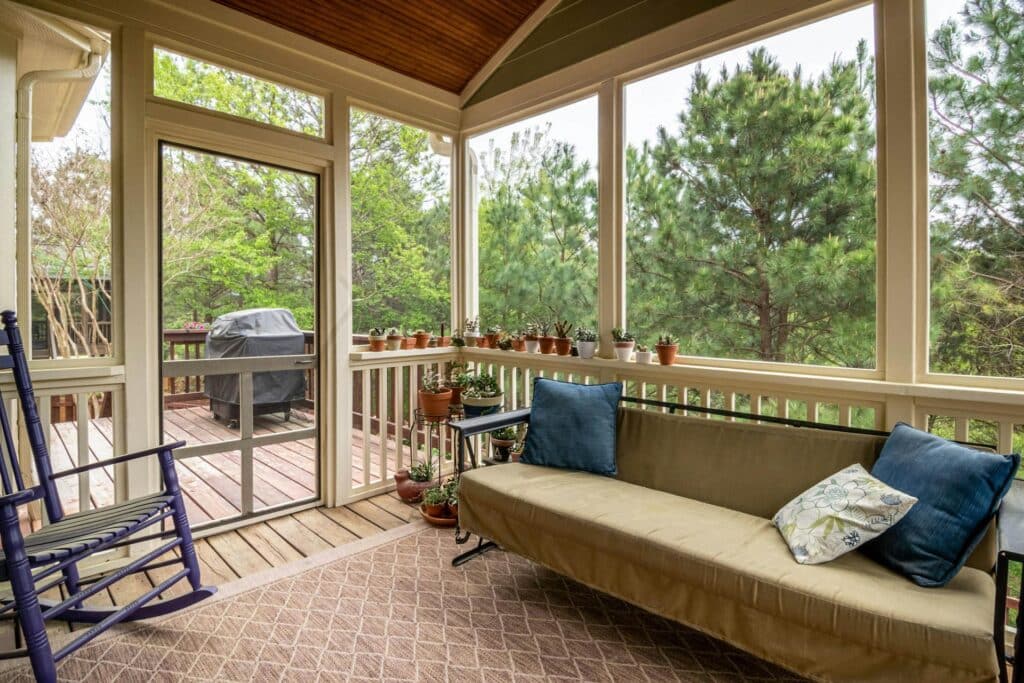
Whether you prefer to sit on your porch solo with a good book or plan on using it to host parties, enhancing the comfort of your sunroom is possible (and often essential) to getting the most out of your home.
Especially in a climate like the Susquehanna Valley, where the hot season lasts for nearly half of the year.
This article aims to provide a comprehensive financial overview of various cooling solutions, helping homeowners make informed decisions that balance comfort with cost-effectiveness.
Factor Influencing Cooling Costs
Everyone’s porch is a little bit different and these details can offer quick insights about setting realistic expectations for the project.
Several key factors dictate the overall cost of cooling a screened porch:
Porch Size and Orientation
If your porch faces south, anticipate a higher investment than a home that receives less sunlight. There are ways to reduce your screened porch cooling costs but if you’re looking for a quick fix to impact the upcoming season, you’ll likely have to allocate more capital at first and less over time.
Take the size of your sunroom into consideration, too. Smaller rooms cool more quickly than larger ones.
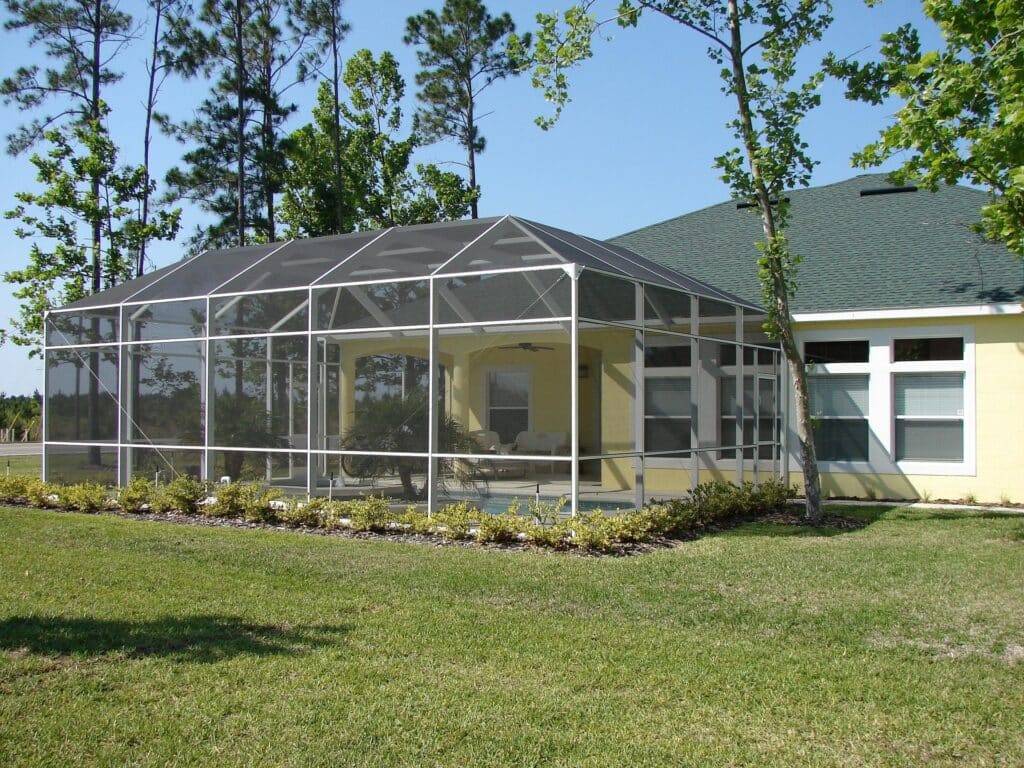
It’s common in York, Lancaster, and Lebanon, Pennsylvania for homes to be surrounded by fields. Whether it’s a neighboring farm or a grassy expanse, if the sun is beating down on your home and there’s no shade in sight, you’re in for a grueling summer, placing more strain on your cooling system.
Read more about how to deal with this kind of persistent heat by shading your home with trees and adding plants with vast groundcover.
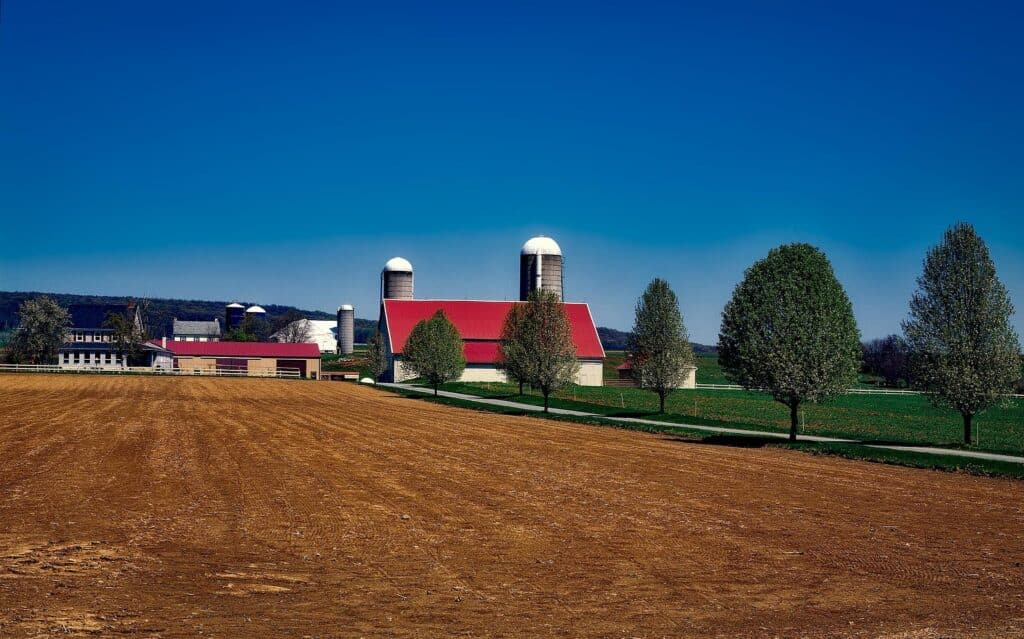
Climate
The local climate plays a crucial role. Humid environments may necessitate different solutions than dry ones, and regions with extreme heat will demand more powerful cooling systems compared to those with moderate temperatures.
There’s no way to avoid the muggy weather that takes over Southcentral PA. With a history of being hot, humid, and oppressive, sometimes the only way to endure the weather in this area is to create your own controlled climate.
But what if you want that luxury to extend to your porch? Maybe you enjoy watching the rich wildlife of Lancaster and Berks County in the morning? Or you have a yard full of flowers from the Philadelphia Flower Show that you don’t want to miss while they’re in bloom? A sunroom AC is a great addition for people who can’t get enough of the outdoors but live in a region with extreme heat.
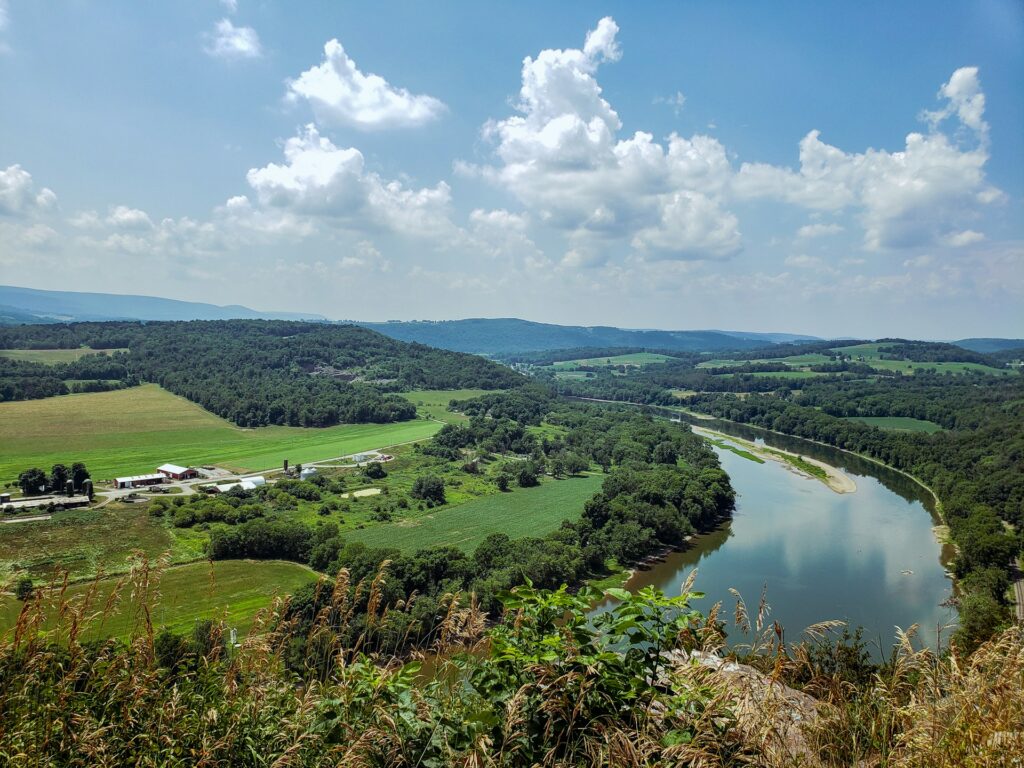
Keep in mind that neighboring counties can experience slightly different weather, even in the same state. For example, if you live in Pennsylvania, you’ll find that the heat may ease up much sooner in Chester County than if you live in Lancaster County.
Although the weather of these two locales doesn’t vary by much in the summertime, Lancaster is located in a valley (Susquehanna Valley) while Chester sits at a higher elevation. This means that Lancaster suffers through the summers at a higher humidity, and that it takes more time to naturally temper the area following a heat wave. Chester will also have to tolerate the heat, but because the land sits higher, it will ultimately remain cooler and drier, making it a more affordable region to tolerate.
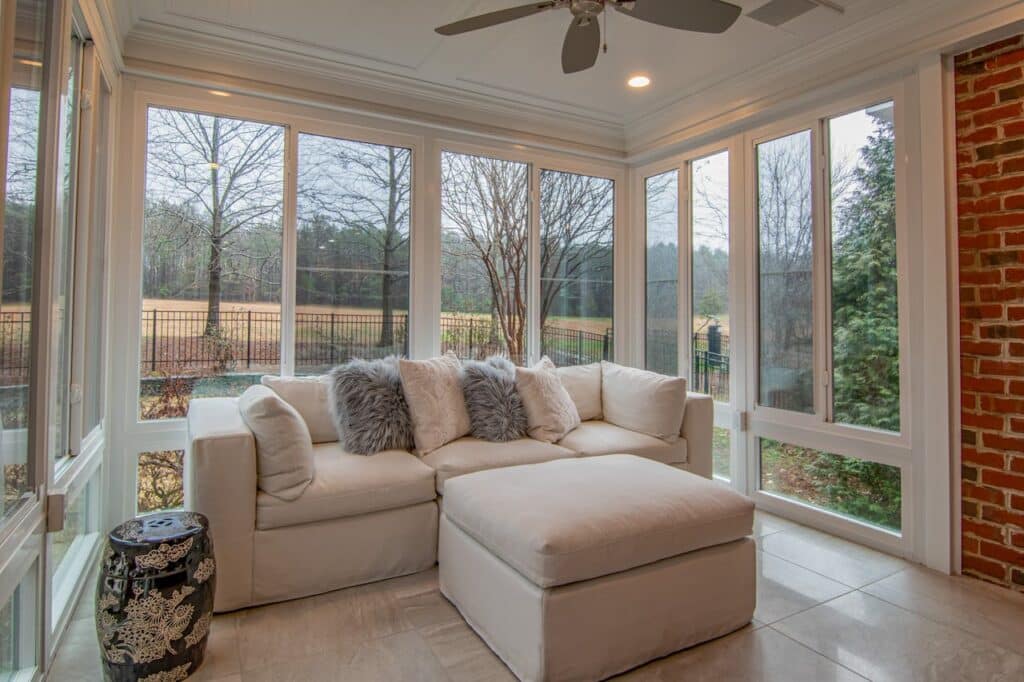
Desired Comfort Level
The extent of cooling desired, whether it’s basic spot cooling for a small area or a broader temperature reduction across the entire porch, will influence the chosen solution and its associated costs.
Think about your unique cooling needs. Do you keep your indoor thermostat on the lower side? Do you want the same for your sunroom? Understand your household’s needs and be realistic about what it takes to achieve your definition of comfort. A screened porch fan may be all you need if you are solely looking for airflow and not a constant stream of cold air from a sunroom air conditioner.
If you want complete climate control rather than steady airflow or spot cooling, use that knowledge when you weigh your priorities.
DIY vs. Professional Installation
The decision to undertake a do-it-yourself (DIY) installation versus hiring a professional significantly impacts labor costs.
Some homeowners and layouts do require less assertive upgrades, and oftentimes these are the best-suited projects for DIYers. While DIY can save money upfront, professional installation often ensures optimal performance and longevity.
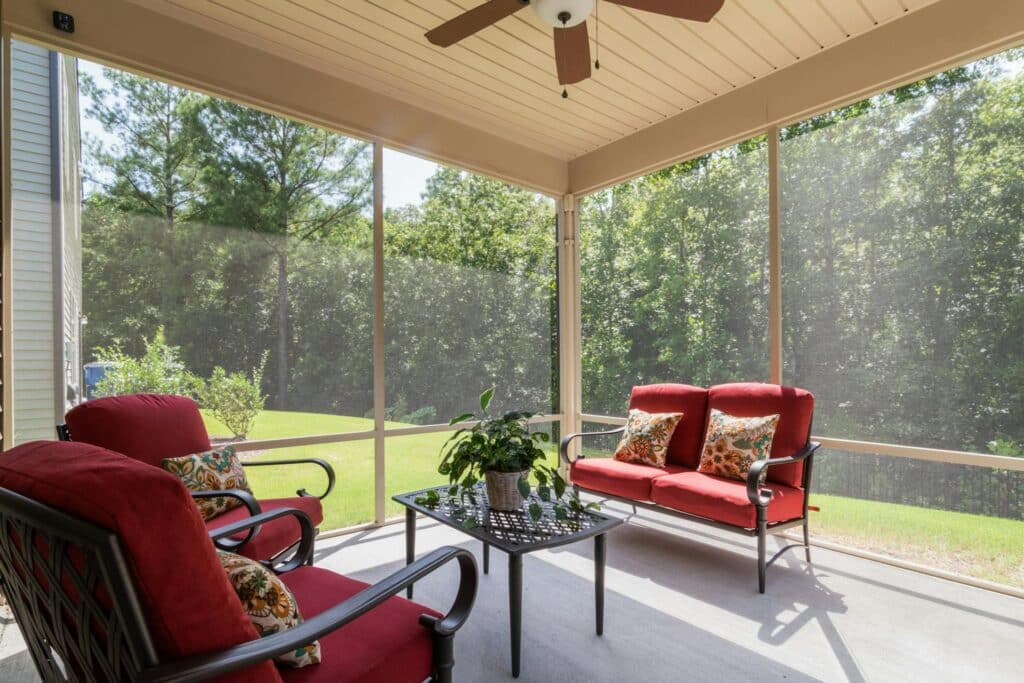
Quality of Materials & Equipment
The market offers a wide range of products, from budget-friendly options to high-end, premium equipment. The quality of materials and the reputation of the brand will directly affect the initial investment.
These decisions can be easier when taking into account professional recommendations, personal preferences, the property’s value, or other factors that may require premium equipment.
Cost Breakdown by Cooling Solution
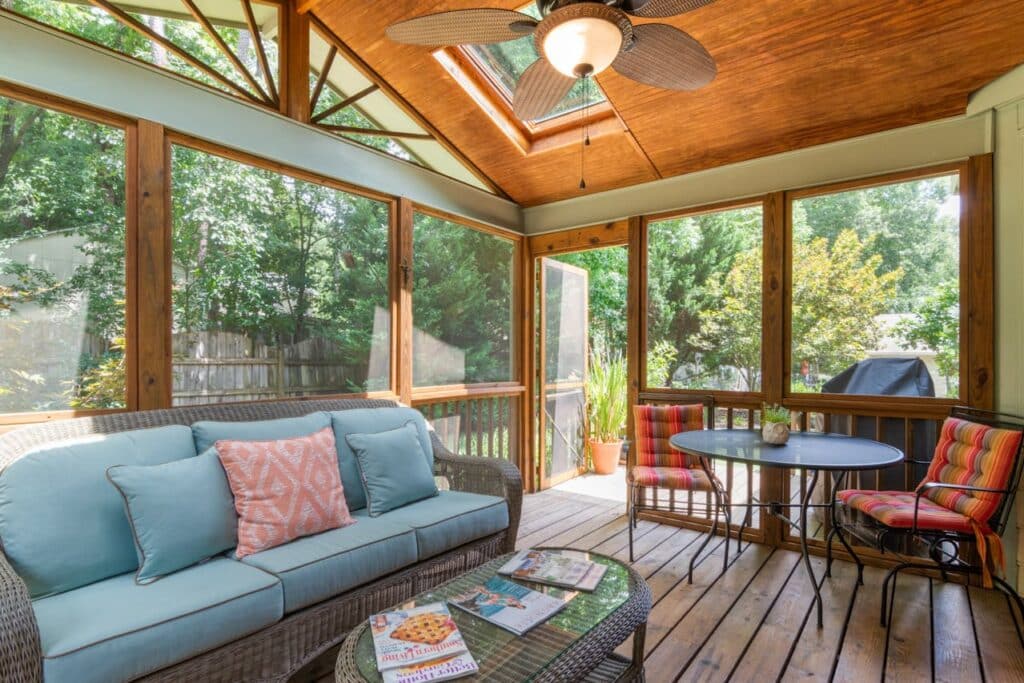
Fans (Ceiling, Window, Portable):
- Initial Cost: Ranges from $50 for basic portable fans to $500+ for high-quality, outdoor-rated ceiling fans.
- Operating Cost: Very low, typically a few cents per hour, making them highly economical to run.
- Benefits: Provide basic air movement, enhance comfort through convection, and are highly affordable entry-level solutions. Fans are often remarkably effective starting points since Southcentral PA experiences less ambient wind than other parts of the East Coast.
Shading Solutions
- Initial Cost: Varies wildly, from $50 for basic outdoor curtains to $3,000+ for custom retractable awnings or pergolas. Some of these options can be DIY-friendly while others are best installed by a seasoned professional.
- Operating Cost: Zero, as they are passive cooling solutions.
- Benefits: Crucially prevents heat gain by blocking direct sunlight, offers excellent UV protection, and can significantly enhance the aesthetic appeal of the porch. Furnishing with plants also cools the air naturally through respiration and pulls the moisture from the air, acting as an off-grid dehumidifier. These additions decrease the demand on other cooling methods, reducing the home’s overall energy usage.
- Limitations: Passive cooling isn’t an instant fix and sometimes still requires active cooling features to deliver complete comfort.
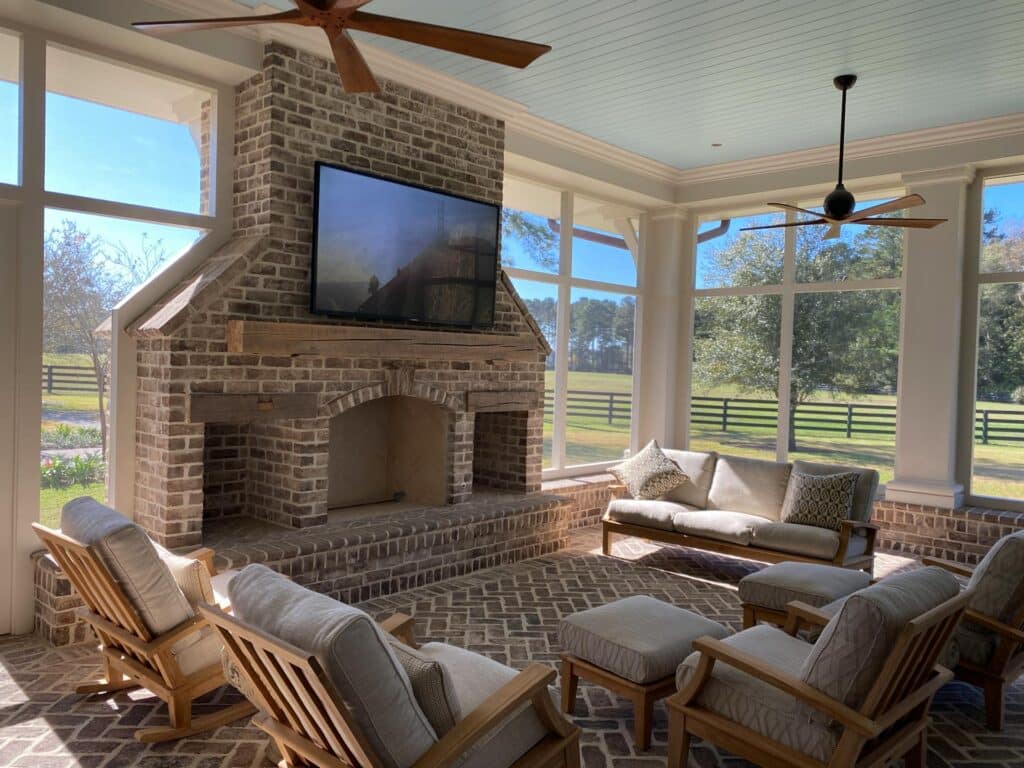
Wall Air Conditioners (Window Units):
- Initial Cost: Ranges from $200 to $700+ for a standard window-style unit. Installation can be DIY or involve a modest professional fee if a new opening needs to be framed.
- Operating Cost: Moderate, similar to portable ACs but generally more efficient as they exhaust heat directly outside.
- Benefits: Provides significant cooling for a specific area, is more effective in partially enclosed or smaller screened porches, and has a lower upfront cost compared to ductless systems.
- Limitations: Requires a window or a specially framed wall opening, can be less aesthetically pleasing, and may not be as effective in truly open screened porches due to air leakage.
Portable Air Conditioners (Limited Use):
- Initial Cost: Ranges from $200 to $700+.
- Operating Cost: Moderate (higher than fans, generally lower than extending central AC).
- Benefits: Offers spot cooling for a specific area, provides immediate relief in targeted zones.
- Limitations: Less effective in truly open screened porches due to significant air leakage, requires venting to the outside (often through a window), and can be bulky, limiting space.
Ductless Air Conditioners (Mini-Splits):
- Initial Cost: Ranges from $1,500 to $5,000+ for a single-zone unit, including professional installation. Costs vary based on BTU capacity and brand.
- Operating Cost: Moderate to high, depending on usage and energy efficiency (SEER rating). Significantly more than fans, but generally more efficient than extending central AC.
- Benefits: Provide comprehensive cooling and dehumidification, effective in all climates, quiet operation, and precise temperature control. It can make a screened porch feel like an extension of the indoor living space.
- Limitations: Upgrades like this are not always within the homeowner’s immediate cooling budget, but can often be financed through a licensed HVAC provider.
Eliminate the guessing game and learn more about each system. Our blog on How to Choose the Right Air Conditioner for Your Home lays out the details so you don’t have to keep researching.
Assessing the Return on Investment

Enhanced Usability
The most immediate ROI is the extension of the porch’s usable hours and months throughout the year, transforming it into a more functional and enjoyable living space. And in a climate like Dauphin County, where the hottest hours of the day can stretch as late as 6 pm, your ROI doubles during the hottest months of the year.
Increased Home Value
A comfortable, well-equipped outdoor living space is a highly desirable feature for prospective homebuyers and can significantly increase a home’s market appeal and value.
This advantage compounds in places like Lancaster city, where there’s no limit to what some people will pay for a ready-to-live-in home that’s outfitted with quality climate control and a finished porch to relax. Many residents claim that the air in Lancaster is thick and muggy in the summertime, making it difficult to escape the unyielding heat. Offer prospective homebuyers a perk that they won’t forget. You can also take your humidity control to the next level with in-home humidity monitoring and a cooling system that includes its own dehumidification.
Energy Savings
By making the porch more comfortable and encouraging more time spent outdoors, homeowners might indirectly reduce reliance on indoor air conditioning, leading to potential energy savings. This ROI is rooted in the same method as targeted cooling zones. Some thermostats can even be programmed to adjust themselves during the hours (or days of the week) that you spend the most time on your porch, leading to near-effortless savings in the long term.
Explore the functionality of smart thermostats to see if they’re right for your home.
Quality of Life
The intangible benefits of enjoying your outdoor space, entertaining guests comfortably, and having a dedicated relaxation zone contribute considerably to the overall quality of life.

Since the Susquehanna Valley is known for its elevated humidity, your home might become the best place to be when the heat index climbs into the triple digits. Improving the lives of not only you, but also any elderly relatives or young children who may not otherwise be able to bear spending any time outdoors.
Budgeting Tips for Porch Cooling
- Prioritize Solutions: Determine the most critical needs based on your climate, porch design, and desired comfort level, then prioritize solutions accordingly. While it is possible to mitigate the upfront cost, Pennsylvania homes often need robust cooling tactics due to the sweltering heat, saturating humidity, and frequent thunderstorms brought on by the region’s pendulating temperatures. Be careful, if living in this area, not to underestimate what it may take to enjoy your time outside.
- Phased Approach: Consider a phased approach. Start with more affordable options like fans and shading, then progressively add more active cooling solutions like wall or ductless AC later. This method can make budgeting and incremental relief more accessible as you adjust your financial goals over time. Take a deeper look at how to weigh your needs alongside your budget in our blog: How to Cool Down a Sunroom.
- Consider Energy Efficiency: For active cooling solutions, pay close attention to energy efficiency ratings (e.g., SEER for ductless AC units) to ensure lower long-term operating costs. Gain a better understanding of the SEER rating and check out some energy-efficient units here.
Smart Spending for Outdoor Enjoyment
Effective cooling for a screened porch doesn’t necessarily mean expensive solutions. Instead, it involves smart investment tailored to your specific needs and budget. By carefully weighing the initial costs, operating expenses, and the myriad benefits, homeowners can create a comfortable and inviting outdoor oasis that maximizes enjoyment and potentially adds value to their home.
For detailed comparisons of various cooling solutions, refer back to the pillar article on screened porch cooling.RSC Heating and Cooling is here to help you evaluate your sunroom cooling costs. Schedule an assessment with our HVAC technicians to find the cooling solution that fits your home. Don’t think that you need an on-site review? Give us a call, we’re happy to answer your questions by phone at 717-299-3914.




